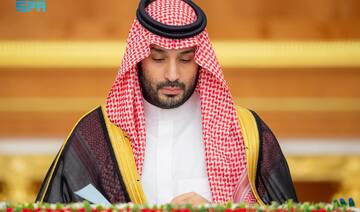MAKKAH: In the heart of Wadi Qarn in Taif governorate, one man’s vision has resulted in one of Saudi Arabia’s most striking heritage landmarks: the National Historical Palace for Islamic Civilization.
Built by Majid Al-Thabiti, the site blends Islamic history with contemporary design, rooted in the symbolism of the number seven.
In an interview with Arab News, Al-Thabiti said: “The number symbolizes perfection and completeness in several Qur’anic verses, including the seven heavens, the seven earths and the seven shaded by God in his shadow, among others.”

The palace includes flooring adorned with colored stones and inspired by the historical art of Sadu, an intangible cultural heritage recognized by UNESCO. (SPA)
The project was born out of Al-Thabiti’s strong will. He believed in his dream and devoted his effort, time and energy to bring it to life.
Spanning 70,000 sq. meters, the palace features seven museums, seven facades, seven gates and almost 7 million stones cut and laid by the man himself.
The museums offer distinct cultural and education experiences. Exhibits cover Islamic architecture, local heritage, plastic arts and sculpture, rare collections, astronomy, military history documenting the unification of the Kingdom and an agricultural museum featuring seeds mentioned in the Holy Qur’an.
The palace includes 600 square meters of flooring adorned with colored stones and inspired by the historical art of Sadu, an intangible cultural heritage recognized by UNESCO.
Al-Thabiti said that he personally cuts, shapes and stacks the stones himself. “The manual labor is what gives the project its true spirit, as every corner bears (my) imprint, effort and dedication,” he added.
He used seven types of stone sourced from across Saudi Arabia, including basalt, quartz and shale. His attention to detail is reflected in features such as hand-shaped facades, floor mosaics inspired by Sadu art and stonework colored in seven hues that mirror the Kingdom’s geological diversity.

Majid Al-Thabiti used seven types of stone sourced from across Saudi Arabia, including basalt, quartz and shale. (SPA)
Highlights at the palace include an Abbasid-style minaret with a water fountain in honor of Zubaida, the wife of Harun Al-Rashid; an observatory used to track the crescent moon; and stone engravings of Saudi megaprojects like NEOM and The Line.
The site also includes engravings on stone of the Kingdom’s military vehicles, such as a fighter jet and ship.
Al-Thabiti also built a 700-meter sports track along the banks of Qarn valley, a stable for purebred Arabian horses, as well as replicas of symbolic gates like Makkah Gate, Taif Gate and King Abdulaziz Islamic Gate, with stones from Mounts Al-Nur, Thawr and Uhud. Other exhibits, like Diriyah and Yawm Badina (The Day We Began), commemorate key moments in Saudi history.
According to Al-Thabiti, his goal is to transform the palace into a cultural and educational destination that celebrates the Kingdom’s history and heritage.
“We possess a great civilizational legacy and a deep-rooted history. It is our duty to present it to the world in the finest way. This palace is the beginning,” he said.

































